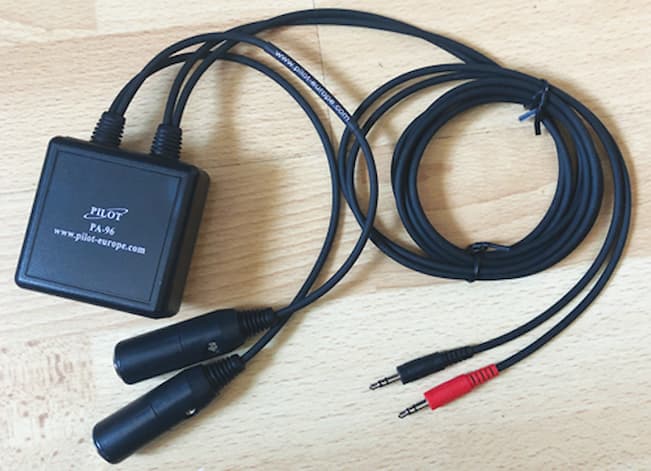A flight is never just about the take-off and landing. Pilots go through checklists, walkarounds and system checks to make sure everything is operating as it should, as every instrument has a role in keeping the aircraft safe and the pilot prepared.
Among all the switches, dials and screens, there’s one item that’s often taken for granted: the audio or headset cable. As important as radios, headset cables are what connects the pilot to the tower, crew members and even passengers. Essential for clear and continuous communication in all flying conditions, aviation headset cables may look simple, but they’re not.
Types of Aviation Headset Cables

Lemo
The Lemo connector is a 6-pin plug most often found in newer aircraft. They’re commonly used with high-end headsets since one of the biggest benefits of Lemo aviation headset cables is that they can power the headset directly from the aircraft. This means no batteries are needed, and thus you can keep your setup on the lighter side without worrying about mid-flight battery changes.
Dual GA
The most common solution is a dual GA cable. These cables use two separate plugs, which is why they’re often found in training aircraft and most aeroplanes. One plug handles the microphone while the other is used for the speaker. Dual GA headset cables are quite reliable and easy to set up, which is what makes them so popular nowadays. This also makes them a safe option for most GA pilots.
U174
Helicopter pilots will be familiar with this one. The U174 is a single-plug cable that’s built to handle vibration-heavy cockpits, and helicopter cabins are exactly that. U174 headset cables lock in tightly, which helps them stay connected no matter the amount of vibrations coming through. This also makes them quite durable, as their sturdy design is what has made U174 cables used almost exclusively in helicopters, however, they can be found used in military fixed-wing aircraft too.
XLR
A 5-pin XLR is another solution that’s able to power the headset from the aircraft. Found mostly in commercial and airline aircraft, these headset cables are known for being secure, thanks to their clear click-in mechanism. Like Lemo cables, XLR cables help keep your cockpit’s clutter to a minimum since you don’t need additional power sources and aviation headset replacement cables or spare batteries.
Twin
The twin plug cable makes for connections that are a bit more specialised. Some mil-spec headsets or older intercom systems make use of twin headset cables. They come as two connected plugs but aren’t the same as dual GA cables. Twin plug cables often require the use of specific headsets, and, because of that, you don’t usually find them in most private aircraft.
Fischer
Fischer cables, on the other hand, are high-end circular plugs found on more advanced communication systems. These cables are quite precise and thus made for specific headsets, typically used in high-performance or business-class aircraft. While not as common as some other cables, their solid connection, sealed design, and durability make Fischer cables rather popular in premium aviation setups.
What Matters in an Aviation Headset

Sound Quality
Clear sound isn’t a bonus, it’s a must. Poor quality audio can lead to badly interpreted messages from ATC or confusion with passengers. Bad headset sound is also often caused by worn or faulty aviation headset replacement cables. When buying aviation cables, make sure they support the full sound performance of your headset.
Bluetooth
Some modern headsets come with Bluetooth, which is handy for pairing with phones or tablets. This helps pilots handle calls or listen to alerts without switching between devices. If your headset or cable has Bluetooth compatibility built in, make sure it doesn’t interfere with the aircraft’s communication systems. Certain headset cables include Bluetooth modules for added convenience.
ANR vs PNR
ANR (Active Noise Reduction) headsets reduce unwanted sounds by cancelling out background noise electronically. These headsets usually rely on battery power unless the headset is getting power directly from the panel using a Lemo or XLR aviation headset extension cable. PNR (Passive Noise Reduction) headsets don’t need power and use thick ear cups for noise isolation. Knowing what type of headset you have can help you choose the right cable more easily.
Adapters
Aircraft plug types aren’t always standard, meaning the same headset might need different plugs in different aircraft. That’s where adapters come in. You can use a dual GA-to-Lemo adapter, or a U174-to-GA one if needed, depending on the setup. Aviation headset extension cables and adapters make a big difference, especially for pilots who fly different aircraft on a regular basis.
Conclusion
A good headset is only as reliable as the cable that connects it to the aircraft. Whether you’re flying a light aircraft, a helicopter, or a jet, headset cables are what keep communication between different sources possible. Picking the right cable means less cockpit clutter, better audio, and an overall more comfortable flight.
























